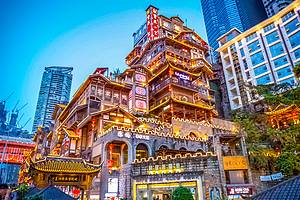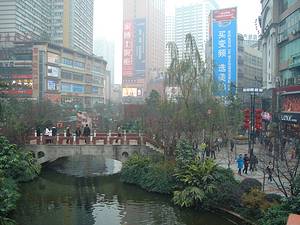The beauty of the autumn sunset around Chongqing
4 cities |
11 attraction(s) |
total distance 700
km
 TIPS
TIPS
Day1
Day2
Day3
Day1: Chongqing > Bijie > Liupanshui
5 attraction(s) ·
648 km
2
This shop is a chain restaurant decorated with Miao elements. It is said that there are performances at night, and the waiters will also toast the diners. Recommended dishes include Dianjiang tuanyu (a type of fish dish with few spines, sour broth, freshly slaughtered fish, and tender meat) and steamed pumpkin with glutinous rice, which is fragrant and delicious.
174
km
3
Leek Terrace: Located in Haijia Village, Dawan Town, Zhongshan District, it is named after the wild leeks growing on the mountainside. The main peak is about 90 kilometers northwest of the city center, with an elevation of 2900.3 meters. It is the highest peak in Guizhou Province and is known as the "Roof of Guizhou". The ridge of Leek Terrace runs northwest to southeast, with a gentle and long slope on the south side and a steep short slope on the north side. The ridge of the ridge extends above the group of peaks, with peaks on the peaks and ridges outside the ridges.
58
km
4
When you come to Liupanshui, trying the local specialty of hotpot is a must. This restaurant is located in the ancient city and has a public parking lot, which is quite convenient. You can also purchase discounted deals online, which are affordable. The ingredients are fresh, and personally, I think the local tofu is especially delicious and fragrant when pan-fried. The pickled pepper beef, ice jelly, pork intestines, and skewered meat are all good choices. The only drawback is that it splatters oil a bit, so you need to be careful.
11
km
5
Day2: Liupanshui
4 attraction(s) ·
29 km
2
The ancient ginkgo village of the world specifically refers to the Tuole ancient ginkgo village in Shiqiao Town, Pan County, Guizhou Province, China. The Tuole ancient ginkgo village is located in Tuole Village, Shiqiao Town, Pan County, Guizhou Province, which is known as the "Cool City" of China. It is a famous scenic area in Guizhou Province with clear water, ancient trees, small bridges, and unique mountains near temples. The village has over 1,450 ancient ginkgo trees growing in a continuous forest, with an average age of over 300 years and the oldest one being over 1,200 years old. The trees are tall and have a diameter at breast height ranging from 100 to 200 cm, with the largest being 220 cm. The tree crown height ranges from 15 to 30 meters. It is the place with the highest density and best preservation of ancient ginkgo trees in the world and enjoys the reputation of "the hometown of ancient ginkgo trees in the world". The Tuole ancient ginkgo scenic area is located in the central part of the ancient ginkgo scenic area in Pan County, with 1,450 ancient ginkgo trees, the most concentrated in the world, which forms a rare and profound tree culture of "people and trees coexisting" and is known as the "world living fossil base".
26
km
3
Buffet, fruits, toppings, ice cream, roast meat are available. Comparatively rich in options. Seafood is not very fresh, especially the shrimp has a peculiar smell and dark color. The sushi taste of Japan's standard is not very good. The freshly sliced steak is well-seasoned, tender, and has a good texture. The desserts are average, and the cheesecake is not very soft.
3
km
4
Day3: Zunyi
2 attraction(s) ·
25 km
1
Delicious, delicious. The taste is truly authentic, a genuine beef restaurant. The meat is exceptional, very fresh. We pre-ordered the dishes in advance today, otherwise we would have missed out on the fresh meat again. So, friends who plan to come here, remember to reserve the fresh meat in advance. Highly highly recommend their clear soup, it's especially delicious.
25
km
2
Hailong Tuen is located on Longyan Mountain in Shuanglong Village, Hailongtun Village, Gaoping Town, Huichuan District, Zunyi City, Guizhou Province. It is also known as Longyan Tuen. It is 28 kilometers away from the main urban area of Zunyi City and is located on the northern slope of the Yungui Plateau, which transitions to the Sichuan Basin. It stands on the Longyan Mountain, the eastern branch of the towering Dalou Mountain, and is an important cultural relic of the Southwest Baozhou Yang Clan in the Song, Yuan, and Ming dynasties. The highest altitude on the Tuen is 1354 meters, and the altitude below the Tuen is 974 meters, with a relative height difference of about 300-400 meters. The top of the Tuen is flat, with an area of about 1.59 square kilometers. There are nine passes built before and after the Tuen. There are six gates in front of the Tuen, namely, Tongzhu Gate, Tiezhu Observing Gate, Feihu Gate, Feilong Gate, Chaotian Gate, and Feifeng Gate. There are three gates built behind the Tuen, namely, Wanan Gate, West Gate, and Rear Gate. Between the nine gates, each gate is connected by protective walls, extending for more than ten miles along the mountain, showing a unique spectacle. At the top of the Tuen, there are buildings such as a yamen (government office) and a training ground, which are grand and spectacular in scale.





























